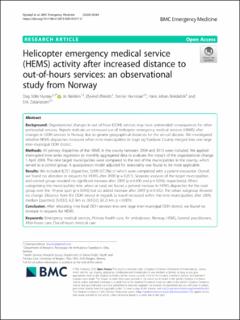| dc.description.abstract | Background
Organizational changes in out-of-hour (OOH) services may have unintended consequences for other prehospital services. Reports indicate an increased use of helicopter emergency medical services (HEMS) after changes in OOH services in Norway due to greater geographical distances for the on-call doctors. We investigated whether HEMS dispatches increased when nine municipalities in Sogn og Fjordane County merged into one large inter-municipal OOH district.
Methods
All primary dispatches of the HEMS in the county between 2004 and 2013 were included. We applied interrupted time series regression to monthly aggregated data to evaluate the impact of the organizational change 1 April 2009. The nine target municipalities were compared to the rest of the municipalities in the county, which served as a control group. A quasipoisson model adjusted for seasonality was found to be most applicable.
Results
We included 8,751 dispatches, 5,009 (57.2%) of which were completed with a patient encounter. Overall, we found no alteration in requests for HEMS after 2009 (p = 0.251). Separate analyses of the target municipalities and control group revealed no significant increase after 2009 (p = 0.400 and p = 0.056, respectively). When categorizing the municipalities into urban or rural, we found a general increase in HEMS dispatches for the rural group over the 10-year span (p = 0.045) but no added increase after 2009 (p = 0.502). The urban subgroup showed no change. Distance from the OOH service in regards to travel increased within the nine municipalities after 2009, median [quartiles] (5.0[3.0, 6.2] km vs 26.5[5.0, 62.2] km, p < 0.001).
Conclusion
After relocating nine local OOH services into one large inter-municipal OOH district, we found no increase in requests for HEMS. | en_US |

